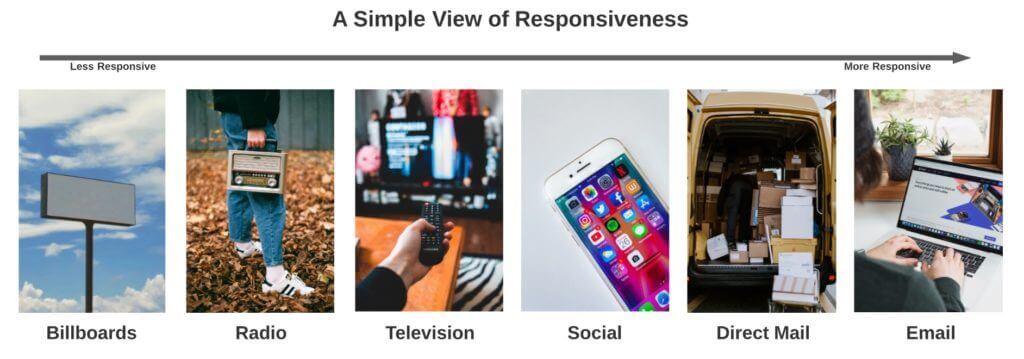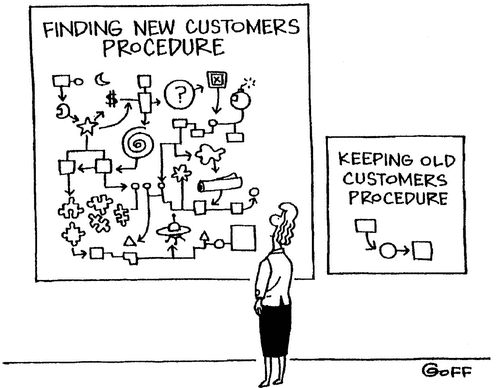I’ve been lucky enough to straddle the world’s move from analog to digital (which makes me old, kids). My data-driven career started in direct mail and then, like the rest of the world, moved to the internet in the ’90s.
And I’ve noticed something important…
We’ve forgotten how to be responsive. And it could be costing you business.
From my experience, our loss of customer responsiveness began with “broadcast” advertising with mediums such as television, radio, newspaper, and magazines. Despite the promises of “1:1” marketing, digital marketing exponentially accelerated with the rise of Google, Facebook, and Amazon’s dominant market positions. In many cases, digital marketing these days is more like old broadcast marketing.

Imagine being a door-to-door salesperson in the 1950s. You knew right away what customers liked and didn’t like. You knew it in real-time. However, if your company advertised on TV, in the newspaper, or on the radio, the company could reach many more people than you could on your route that day. What likely happened is that advertising enhanced your ability to sell. It enhanced that one-to-one relationship. The company didn’t take you off your route just because it was advertising.
Broadcast advertising works as long as you understand the power in the hands of the broadcaster. They own the customer relationship. If you are a large enterprise, then you can perhaps afford to bargain for better advertising rates. For the rest of us, we continued forward, believing that “digital marketing” is how it had to be now. Move all of my advertising from “old school” and buy search keywords (controlled by Google), advertising on Facebook/Instagram (using black-box algorithms), or sell through Amazon (where you often aren’t even legally allowed to use the buyer details for follow-up).

Source: Ted Goff
Now, let’s put that in modern terms. If you depend on advertising via Google, Facebook, and Amazon and you are not developing high-ROI one-to-one customer relationships, you have a problem. Yes, you likely don’t have a door-to-door salesperson. But, you do have other ways to cultivate profitable long-term customer relationships. It is so much easier to keep a current customer than it is to find a new one.
The top solutions that work one-to-one are email marketing and good ole direct mail.
These are two media messages that arrive where your customer is, sent to them specifically, with their name on the message. It is this personalization (you choose the person to whom you promote, and you promote to them personally) that defines a direct relationship. Above all, direct marketing is responsive marketing in that you know what your customers are saying and buying. They become more than a statistic; they become people.
The typical small or medium-sized business, generally under $50M in sales, must learn to work with Google, Facebook, and Amazon (and broadcast media if they can afford it). As long as your marketing achieves well-reasoned key performance metrics, you should absolutely keep advertising with giants such as Google, Facebook, and Amazon. Broadcast and “big” digital advertising absolutely can work. When it does achieve your performance metrics, absolutely keep doing it and optimize every step.
However, it would help if you did not fall prey to the newest-of-the-new bright and shiny solution offered in the digital marketing world. They are generally a waste of effort and a distraction away from success. Learn how to test new channels and techniques before investing heavily in them. Prove that they work (meet YOUR performance metrics) before devoting a significant portion of your budget.
At the same time, businesses must clarify their message and develop direct consumer relationships. Now. This is an absolute imperative.
The reason why is that things are changing quickly. Apple is about to force Facebook to play on a more level field with consumer data. Google is on the road to killing third-party cookies (tracking), which allows for detailed individual-level data to be used in ads. Regulatory efforts are underway to change the way Amazon deals with its merchants. None of these big players are in any danger of going away. However, all will be forced to change and it can bring you a real opportunity. Only businesses that have and keep direct relationships with customers will survive and thrive.
So what should we all do?
First, develop your email list. If you are a larger firm, hire a professional communications firm or branding agency with direct marketing experience. Then listen to them. Their experience will help you. For smaller businesses, no matter how small, I suggest looking at Marketing Made Simple from StoryBrand. It is a repeatable framework for developing an email-based sales funnel that will start your journey.
Next, experiment with direct mail. Really, direct mail. You know, the mail that arrives in an actual mailbox. Send it to your best customers and watch the results. It works. And there are great tools out there that make old direct mail a lot like new digital marketing. Heck, start with Mailchimp, which has built-in digitally printed postcards that can work with your email campaigns.
Lester Wunderman, considered by most to be the father of direct marketing, predicted our current predicament way back in 1971:
“Advertising has always been capable of eliciting a response—but only in the nature of a direct marketing dialogue do we find the potential for responsiveness. And if I read our marketing and social revolution accurately, responsiveness is the only road to a technology which will serve people instead of enslaving them.” – Lester Wunderman, 1971
This was before the modern computer and long before the internet was anything at all.
Responsiveness is produced by talking with customers, not at customers. Good communication is how humans are made to work. I would argue that eCommerce isn’t explosively growing because of COVID-19; Ecommerce is explosively growing for all businesses that interact well with their customers and treat them like people. We forget, but this is like mail-order catalogs when they became possible at scale because of computer databases in the ’70s and ’80s.
Something new will come along too, but the successful technologies will be the ones that connect people with people. The best well-run businesses will communicate directly. Just like right now.
The good news is that you can establish excellent direct customer relationships. There is much reason for optimism. Talk to and listen to your customers. Use tools like email and direct mail that allow you to establish and enhance direct relationships. Don’t be beholden to third parties that take away your voice. Your business and your customers will be stronger as a result. Welcome to the next great age of direct marketing.
“The thing that fascinates me is what is yet to come and what is yet to be and what is yet to be made to happen. And I live in that world.” – Lester Wunderman
Blueprint.Inc is on a mission: to help 10,000 local businesses by 2025 survive and thrive by using our platforms to support and promote them as critical stakeholders in our communities. If we can help you, we’d love to talk!
Jay is Chief Operating Officer at Blueprint.Inc (https://blueprint.inc) based in Nashville, TN (better known as the home of StyleBlueprint.com). He manages financial, technical, and process management, supporting small business clients around the South. He has over 20 years of experience in technology management, software development, strategic business development, and bootstrapped startup companies.
